
Mike K
-
Posts
583 -
Joined
-
Last visited
Content Type
Profiles
Forums
Blogs
Gallery
Events
Store
Posts posted by Mike K
-
-
Hi,
Gents, I disagree with such a tight 1935-1940ish time frame. If you keep your eye open, this type of hinge/pin/catch arrangement is actually NOT uncommon. I have two or three of this same type 1914EK1 (they can come with brass cores and/or frames) and seem to seem them on eBay reasonably regularly - nothing wrong with them either!
This hinge/pin/catch configuration can be found on MANY items from the late teens through to the earliest 40s (the WW2 "Wernstein" hinge being similar but definitely different, so I do not include it). Examples you ask? The earliest year dated Stahlhelm Badges, EK1 equivalents from other kingdoms/dutchies (eg Meck-Schwerin, Braunschweig & Oldenburg), many veterans association and some Freikorps badges (have a look through Detlev's catalogues), early Third Reich pinback awards and earliest wartime - up to and including the early 6+ rivet DKs (1941). So my own time frame for these examples is much broader and ranges from latest WW1 to early WW2. There is another version with a round-wire catch, rather than the classic flat-wire catch.
Imo some clarification on Darrell's first post re "the reverse hardware appears to be like that of the WW2 Schinkel crosses". A WW1 Schinkel is a tautology (at least I'm pretty sure that is a valid term for the phrase!). The earliest WW2 EKs are referred to as "Schinkels" because they have the smaller size and highly curved arms of WW1 (and earlier) crosses.
One more bit of info, my 1939 Schinkel EK1 - which shares the same hinge/pin/catch - also shares the same beading to the frame EXCEPT the beading is badly flawed. To me this indicates serious die deterioration and, as the 1939 Schinkels are interpreted to be earlier examples, the EK1 frame die probably fell apart early in the war when production numbers would have been increased.
Sorry for coming on strongish on this topic, but this style hinge/pin/catch is one of my favourites.
Regards
Mike K
0 -
Hi Joe,
Detail appears OK but the paint riding the beading - assuming that's what we're seeing - is not something I'd expect on an early cross. What are the dimensions - 42, 43 or 44 mm? At this stage, I'm leaning towards 30s or 40s, if not a little bit later.
Regards
Mike K
0 -
Hi Chris,
No order;
EK2 - 1 Juni 1918
EK2 - 3 Juli 1917
EK2 - 30 August 1915
EK2 - 30.11.1917
EK2 - 24.4.1916
Regards
Mike K
0 -
Hi,
Micha, that's a nice EK1! I have a couple of them (both unmarked though), which I think of as "spoon-bills" (after the bird) because of the round shape of the tip of the pin. They also have the characteristic "V" notch at the hinge end of the pin. Interestingly, I have a Braubschweig KVK1 with the same style pin.
Daniel, I don't think Micha's type is a Meybauer - the core details are very different. Look at the size of the W and it's relation to the beading for a start. The crown is also different. You've shown a very nice Meybauer screwback though!
Regards
Mike K
0 -
-
Hi,
How about something dated just after WW1 but definitely WW1 related? "Heimkehrdienst" literally translates as Home Coming Service. Never seen another one like it. Although made in Berlin, Verkulien thought it may be Austrian related.
Regards
Mike K
PS: it came in a ?snake/crocodile skin covered AWS marked (ie matching) case (no insert as such though, just a "felt paper" base) - also a bit of a rarity.
Obverse...
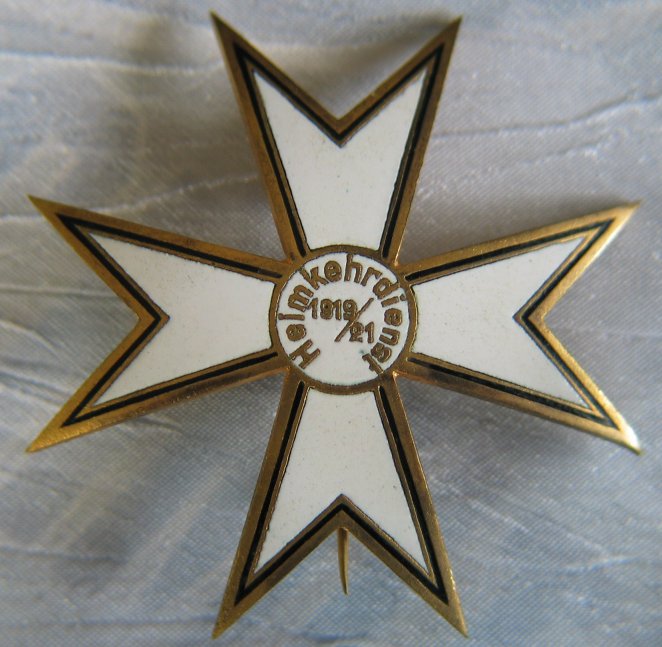
 0
0 -
-
Hi,
I think I can add something to this great thread.
1870 EK2s are not that uncommon and 1870 EK1s aren't quite rare but I can count on one hand the number of this type of period conversion I have seen.
Regards
Mike K
Obverse...
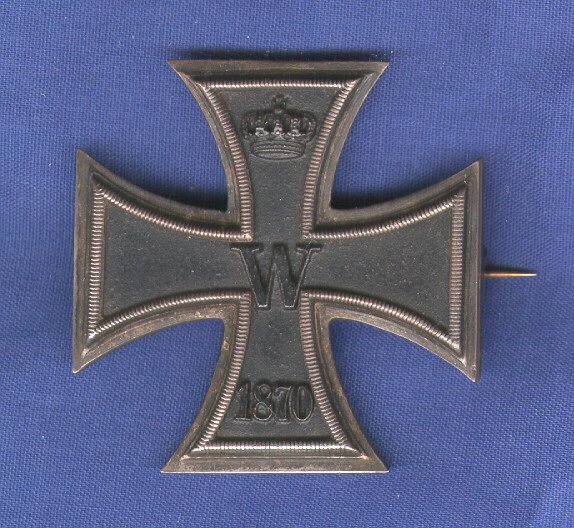
 0
0 -
Hi,
Looking at the marking, another possibility is that it might be the Roman numbers "IV" and therefore some sort of quality or batch mark, rather than a maker's mark.
I have what I think is an "IW" EK2 and both the marking and the core are very different to the example above.
I've seen images of these Victoria DRGM crosses before and there are at least 2 core types. The one imaged here has the very unique crown style.
I don't doubt it's "original" (let's say pre-45) and I could certainly live with Micha's 1920s estimate. Would US$300 be outrageous for one of these do you think?
Regards
Mike K
0 -
Hi,
The basemetal from the images looks silvery to me where exposed (wreath highpoints, boat, top of eagles wings and head, reverse edges) - not the yellow of tombak. Is this just an effect of the imagery? Is what I'm seeing is really high quality burnishing (and therefore shiny reflection)?
Regards
Mike K
0 -
Don't think any one has observed this but Medal ribbon 3 is the opposite coloration of ribbon 4 so one can assume from this that it is also an athletic medal.
Good point!
But does that mean the missing sports medal was for a combattant or non-combattant sport?

Regards
Mike K
0 -
Hi Christophe,
The 4th medal is a Battalion athletics medal - the reverse reads Wettkampf Batl. D 12.Okt.40
The 5th medal is a post-war Austrian vets medal. It reads "?ft. Kameradfchtsbund * Landersverband Ob. ?ft" and on the reverse "F?r befondere Verdienfte" (f=s).
Regards
Mike K
0 -
-
Hi Paul,
I apologise for the seriously delayed reply! I headed off to work soon after I started the thread and only got back late last week.
I seriously doubt the ribbon is for US service. The medal bar is an earlier 57er that appears to have been "padded" with as many dangly nits as possible.
Scans of the entire medal bar to follow.
Regards
Mike K
Obverse....
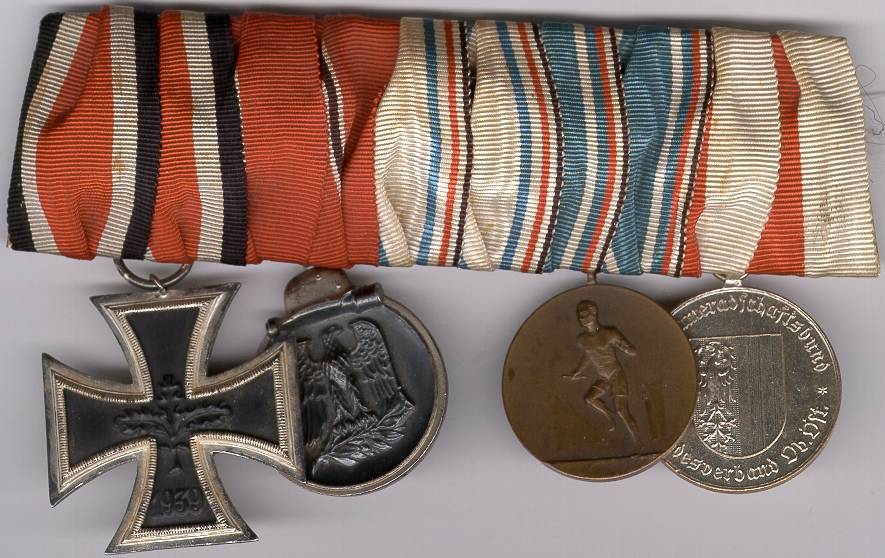
 0
0 -
Hi Larry,
The form of the maker's mark (different font and even/regular size on repros) and the hinge/pin/catch assembly are where the better repros still fall short. Make sure you know the differences between genuine tombak and zinc hinge/pin/catch assemblies. Another area the repro Schwerins can fall down is poor obverse detailing of the shields on the boat. and the sixe of the roundels in the center of the shields. Also, if you're looking for a tombak version, make sure it is fire-gilded and not just gilded (as per the "Cave Creek" repros).
Regards
Mike K
0 -
Hello Mike,
This has turned into a very informative thread.I appreciate your insight into this piece(even though it is not mine).This has opened my eyes to the possibility that these may have existed pre 45.The use of the rivets this way is actually pretty ingenius after you study the appearance of the badge.
Is it known how many companies manufactured this award this way?The reason I ask is,the 50 PAB you have shown and the 25 PAB that started this thread do not appear to be made by the same company.
That aside, the overall fit and finsh of the 25 seems to be lacking,especially when compared to the 50 you have shown.If this piece were offerd to me in my price range I would probably pass for these reasons.
I am not trying to be argumentative.I really want to learn as much as possible,and I only do that by asking questions and making comments.I am willing to accept the possibilty of this manufacturing technique,but I still have issues with the badge in question.
Respectfully,
Jim P
Hi Jim,
Please note, I wasn't arguing specifically for the badge at the top of the thread being original/genuine, only the type in general! The pics of both the 25 and 50 in this thread aren't great. The 50 also has some wear/deterioration which makes comparison of fine details difficult.
I ceraintly agree with some of your points though and could add that the finish on the wreath looks exceptionally good (but is it correctly plated, or is that actually only basemetal) whereas the tank looks worn and has a strange whitish material in the recesses.
As indicated in my first reply, there are no obvious major problems with the 25 BUT, as Rick has re-iterated, there are very good repros in circulation of this type (and the GB marked semi-hollow examples).
I don't know how many manufacturers produced the numbered Panzer Badges - probably no more than 1/2 dozen and maybe only 3 or 4 in total. How many produced the "through rivet" type is not possible for me to say. I would not be surprised to learn that there was only one maker though.
Regards
Mike K
0 -
Hi,
I picked up a 57er medal bar recently (5-place, with EK2 and Ostfront the only obvious military medals) but one of the medals is missing. I have a suspicion it may be for either a veteran's association (possibly Austrian) or some sort of wartime unofficial medal (eg a sporting medal, as there was another wartime sporting medal on the bar).
I've cobbled together the likely full colour/stripe combination from the exposed ribbon on the medalbar to hopefully make ID a bit easier.
If anybody could ID the medal that goes with the ribbon it would be much appreciated! Even better would be if you could also post some pics of the correct medal. I'd like to try and replace it if possible (not for later resale).
Regards
Mike K
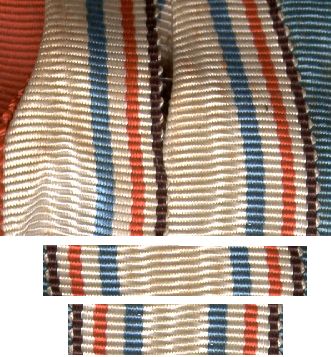
 0
0 -
Hi Don,
Fair questions/comments!
From what I can see, my example and the example you have posted (?Manions?) appear to be constructed the same (the one at the top of the thread has either lost the black paint off the cross or had it stripped for effect. This is the only type I've seen - and I've seen VERY few of them (could literally count them on one hand).
The example in Hamelman is really hard to see. It looks like it may have a wide hinge but the catch seems to be the same as my example. Otherwise the cut-out and construction seems to be the same. The Wound Badge used is definitely a genuine Third Reich example - can't remember the maker as I don't actively collect Black Grade examples. I've attached a scan which shows the construction of my example a little bit better. Note that the hinge and catch actually attach to the rim of the badge, not the back.
I certainly wouldn't pay US$130 for one. From memory I did pay a premium because, as a collector, I wanted one - I already had Hamelman and knew the "real" background but it was still described as a WW1 Chaplains Badge (crazy when it is obviously a WW2 pattern Badge!). It was only about double the price of a standard Black Grade at the time.
Regards
Mike K
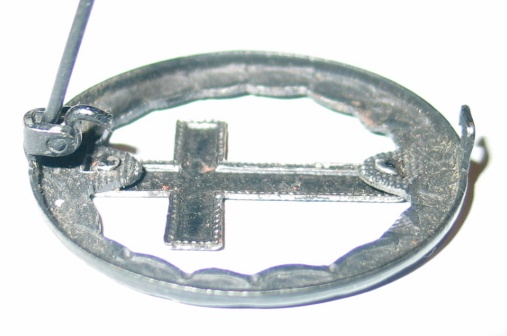
 0
0 -
Reverse scan...
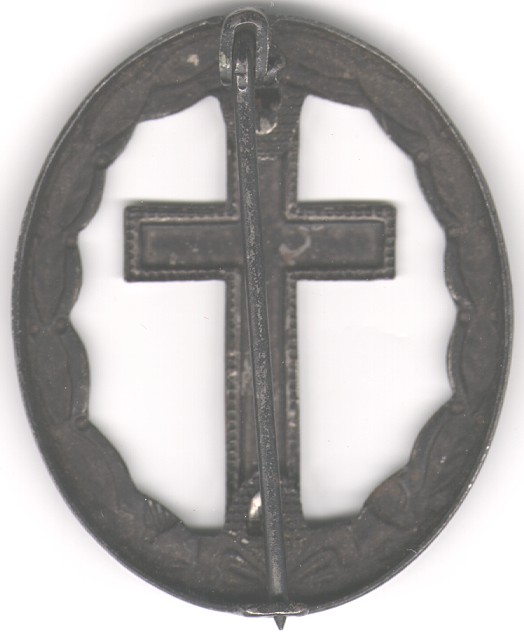
 0
0 -
Did monks make it? I have no idea.
Hi,
Don, I get the feeling that you don't believe the "story" presented in Hamelman's book? For others who may not own Hamelman's Wound Badge book, Hamelman did not write up the story, rather he related the gist of an article written by Gerd Schultz and published in the German INFO Journal, Vol 31, February 1984 (article title "Fromme Heimarbeit"). I guess I'd like to know why the original article, described by Hamelman as "excellent, interesting and WELL-DOCUMENTED" is apparently being derided/dismissed?
If anyone has access to the INFO article, I'd really like to see a copy/scan - please! Post it here or PM me.
Looks like a real badge that was cut up to me.I can't argue with that as that is EXACTLY what the Wound Badges are. They are very nicely done though. However, by dismissing it, imo the interesting history of the badges is being totally disregarded! One could argue that ANY of items we badge/medal/cross collectors drool over are simply lumps of metal.
In this particular case, the indications are that only a "few hundred" badges were converted - as opposed to the tens or hundreds of thousands of standard black wound badges in circulation. I'm quite proud to say that I own one, and every time I pick it up I appreciate it for the history that it represents.
Regards
Mike K
Obverse...
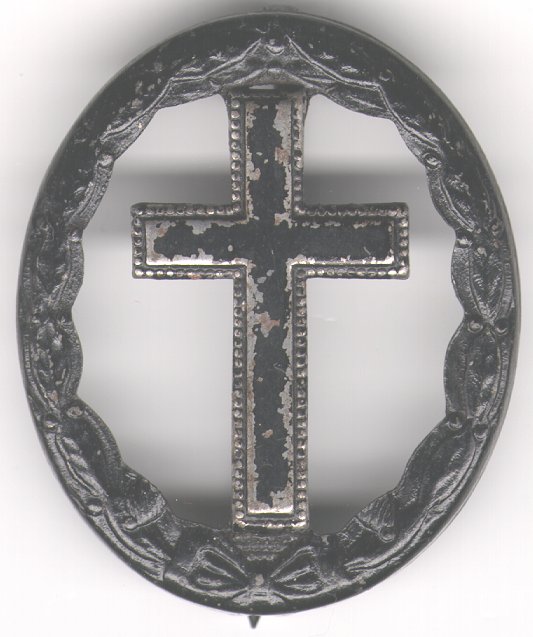
 0
0 -
Mike, is that a Japanese produced badge?
Don
Hi Don,
Yes, apparently so. Still waiting for the officer's name to figure out his ship.
Regards
Mike
0 -
Hi Ronny,
I can only agree, a nice original Wagner. Looks like the reverse was cleaned with a scourer though - probably had a really nice dark patina before that. This example probably has the nicest of the 3 (THREE!) WS cores I am aware of - very fine details.
Regards
Mike K
0 -
Hi Ronny,
The cross looks like a nice Meybauer - high silver content. Worn paint on the obverse but at least no major rust.
Re the engraving, I'll leave that to those more familiar with engraving techniques but from my limited experience it looks like it's been electrically engraved and possibly recently. Noticed the "dot" pattern to form the letters and the total absence of patina in the engraving. The latter observation is in vast contrast to the old silver content mark which now looks black with age patina.
Regards
Mike K
0 -
Reverse...

 0
0


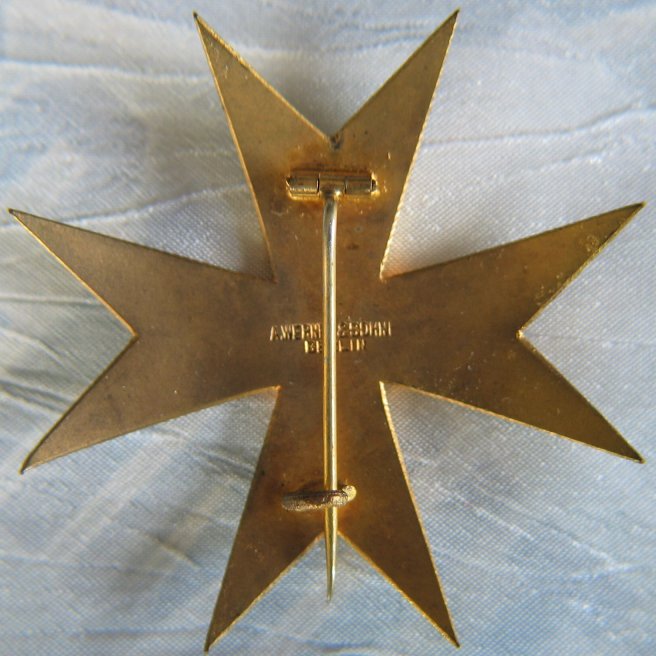
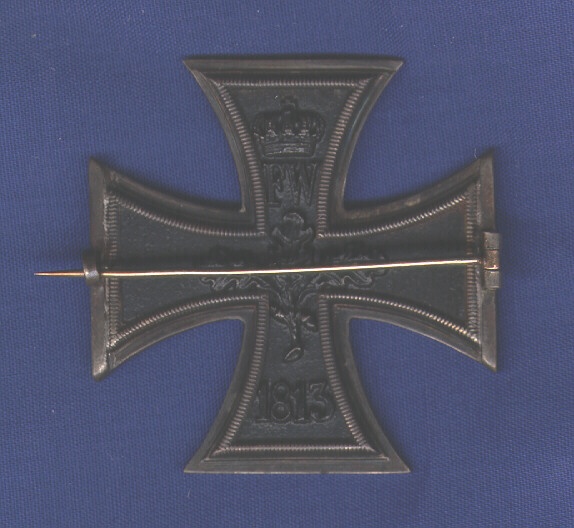
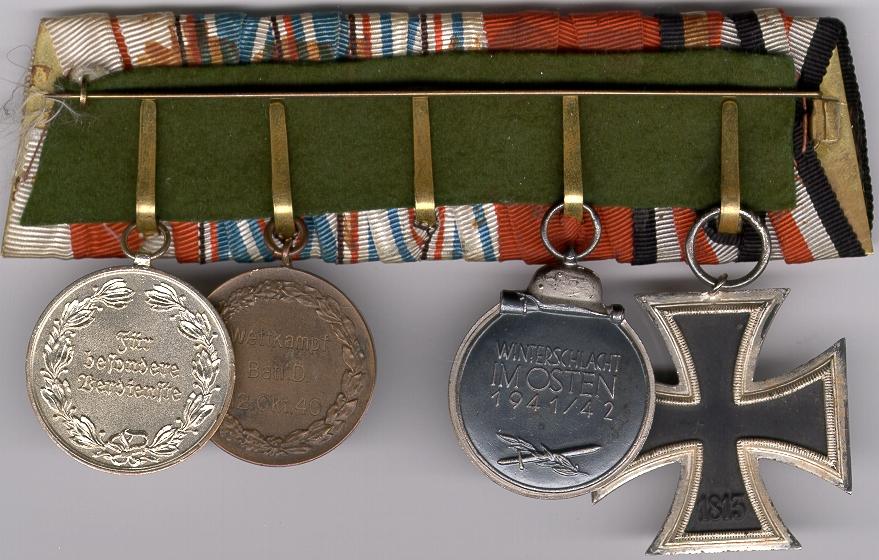
Pilot's Crosses
in Germany: All Eras: The Iron Cross
Posted
Hi John,
I can only agree with the others - WOW - what a great pair of EKs and a I can't wait to see the rest of the grouping.
Regards
Mike K